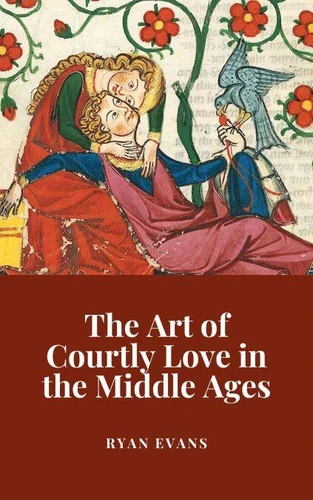The Art of Courtly Love in the Middle Ages
Par :Formats :
Disponible dans votre compte client Decitre ou Furet du Nord dès validation de votre commande. Le format ePub est :
- Compatible avec une lecture sur My Vivlio (smartphone, tablette, ordinateur)
- Compatible avec une lecture sur liseuses Vivlio
- Pour les liseuses autres que Vivlio, vous devez utiliser le logiciel Adobe Digital Edition. Non compatible avec la lecture sur les liseuses Kindle, Remarkable et Sony
 , qui est-ce ?
, qui est-ce ?Notre partenaire de plateforme de lecture numérique où vous retrouverez l'ensemble de vos ebooks gratuitement
Pour en savoir plus sur nos ebooks, consultez notre aide en ligne ici
- FormatePub
- ISBN8227242938
- EAN9798227242938
- Date de parution11/11/2024
- Protection num.pas de protection
- Infos supplémentairesepub
- ÉditeurBig Dog Books, LLC
Résumé
This book explores the tradition of courtly love in medieval Europe, a cultural phenomenon that shaped relationships, literature, and social customs among the nobility. Originating in the courts of France and popularized by poets, troubadours, and noble patrons, courtly love celebrated ideals of loyalty, devotion, and moral refinement in romantic relationships. Although often occurring outside the boundaries of marriage, courtly love introduced a complex code of conduct that emphasized virtues such as chastity, humility, and endurance.
The text examines the influence of courtly love on social hierarchy, chivalric ideals, and gender roles, with particular attention to how noblewomen wielded power as objects of admiration and arbiters of romantic conduct. Through symbols, rituals, and literary forms, the tradition developed a sophisticated language of love that blended Neoplatonic and Christian elements, portraying romantic devotion as a pathway to self-improvement and even spiritual enlightenment.
The work also addresses the tensions between courtly love and the Church's teachings on marriage, the ethical challenges posed by unrequited or extramarital devotion, and the role of secrecy and fidelity in these relationships. Ultimately, the book illustrates the far-reaching legacy of courtly love, tracing its impact on Renaissance literature, modern romance, and contemporary ideals of love as a transformative, aspirational force.
Through its exploration, the book reveals how courtly love continues to shape Western cultural notions of romance, loyalty, and the moral dimensions of personal relationships.
The text examines the influence of courtly love on social hierarchy, chivalric ideals, and gender roles, with particular attention to how noblewomen wielded power as objects of admiration and arbiters of romantic conduct. Through symbols, rituals, and literary forms, the tradition developed a sophisticated language of love that blended Neoplatonic and Christian elements, portraying romantic devotion as a pathway to self-improvement and even spiritual enlightenment.
The work also addresses the tensions between courtly love and the Church's teachings on marriage, the ethical challenges posed by unrequited or extramarital devotion, and the role of secrecy and fidelity in these relationships. Ultimately, the book illustrates the far-reaching legacy of courtly love, tracing its impact on Renaissance literature, modern romance, and contemporary ideals of love as a transformative, aspirational force.
Through its exploration, the book reveals how courtly love continues to shape Western cultural notions of romance, loyalty, and the moral dimensions of personal relationships.
This book explores the tradition of courtly love in medieval Europe, a cultural phenomenon that shaped relationships, literature, and social customs among the nobility. Originating in the courts of France and popularized by poets, troubadours, and noble patrons, courtly love celebrated ideals of loyalty, devotion, and moral refinement in romantic relationships. Although often occurring outside the boundaries of marriage, courtly love introduced a complex code of conduct that emphasized virtues such as chastity, humility, and endurance.
The text examines the influence of courtly love on social hierarchy, chivalric ideals, and gender roles, with particular attention to how noblewomen wielded power as objects of admiration and arbiters of romantic conduct. Through symbols, rituals, and literary forms, the tradition developed a sophisticated language of love that blended Neoplatonic and Christian elements, portraying romantic devotion as a pathway to self-improvement and even spiritual enlightenment.
The work also addresses the tensions between courtly love and the Church's teachings on marriage, the ethical challenges posed by unrequited or extramarital devotion, and the role of secrecy and fidelity in these relationships. Ultimately, the book illustrates the far-reaching legacy of courtly love, tracing its impact on Renaissance literature, modern romance, and contemporary ideals of love as a transformative, aspirational force.
Through its exploration, the book reveals how courtly love continues to shape Western cultural notions of romance, loyalty, and the moral dimensions of personal relationships.
The text examines the influence of courtly love on social hierarchy, chivalric ideals, and gender roles, with particular attention to how noblewomen wielded power as objects of admiration and arbiters of romantic conduct. Through symbols, rituals, and literary forms, the tradition developed a sophisticated language of love that blended Neoplatonic and Christian elements, portraying romantic devotion as a pathway to self-improvement and even spiritual enlightenment.
The work also addresses the tensions between courtly love and the Church's teachings on marriage, the ethical challenges posed by unrequited or extramarital devotion, and the role of secrecy and fidelity in these relationships. Ultimately, the book illustrates the far-reaching legacy of courtly love, tracing its impact on Renaissance literature, modern romance, and contemporary ideals of love as a transformative, aspirational force.
Through its exploration, the book reveals how courtly love continues to shape Western cultural notions of romance, loyalty, and the moral dimensions of personal relationships.






















